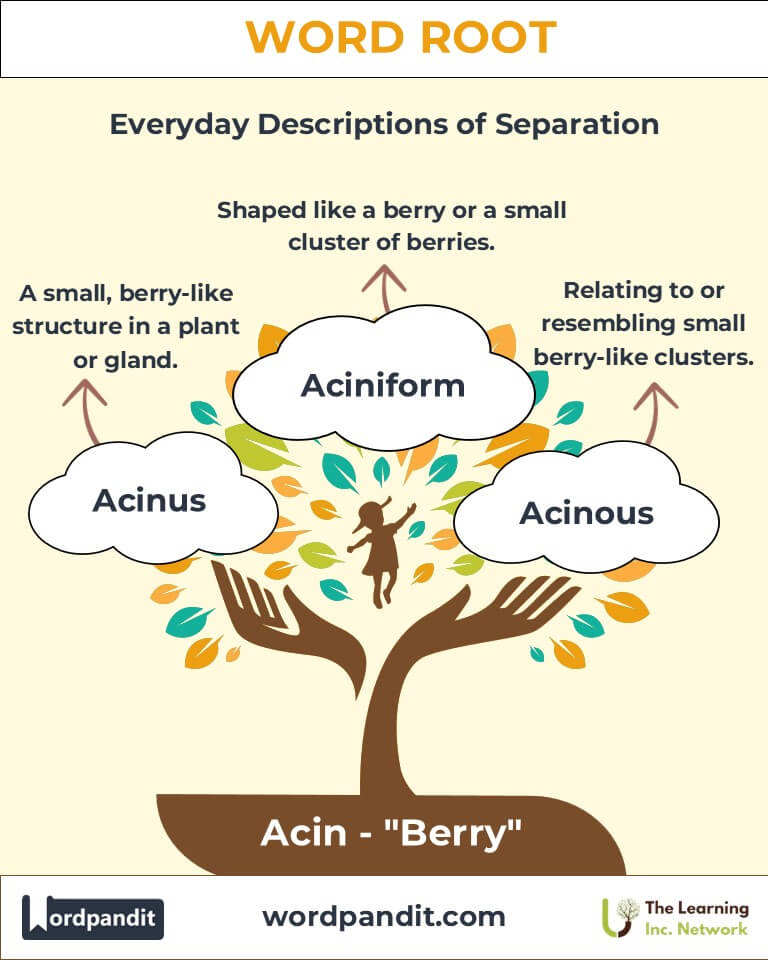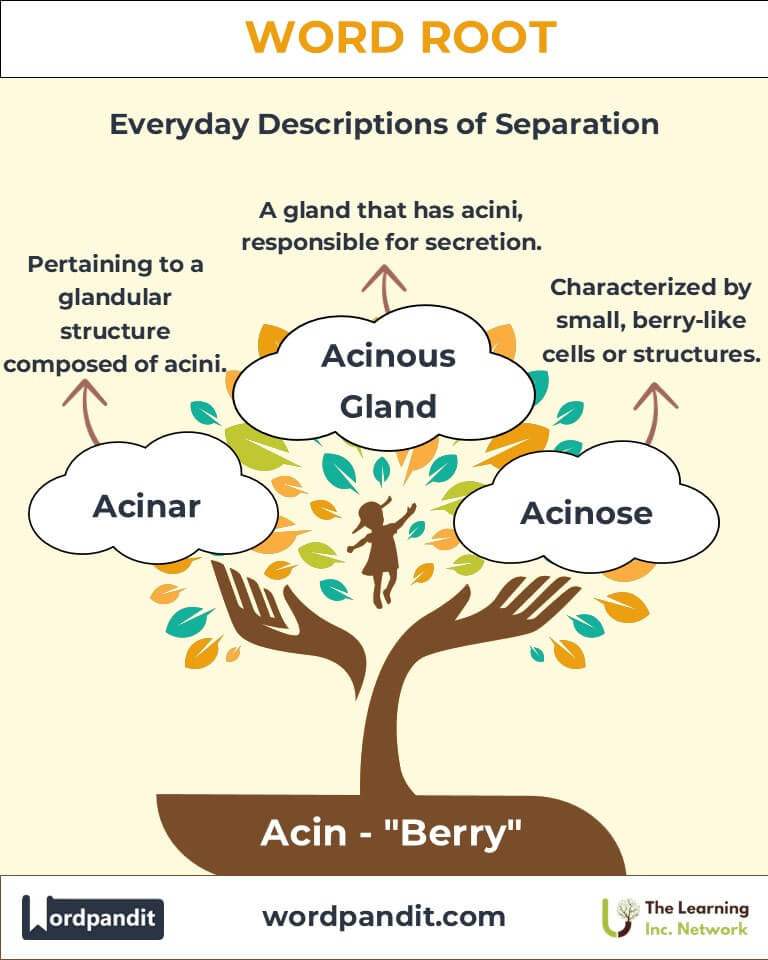Acin: The Grapevine of Meaning in Language and Science
Discover how the root "acin," meaning "grape," has entwined itself into scientific vocabulary and language, symbolizing growth, clusters, and organic beauty. Explore words like "acinus" and "aciniform," which reveal the profound connections between nature and linguistic expression.

Table of Contents
- Introduction: The Essence of "Acin"
- Etymology and Historical Journey
- Mnemonic: Unlocking the Power of "Acin"
- Common Acin-Related Terms
- "Acin" Through Time
- "Acin" in Specialized Fields
- Illustrative Story: "Acin" in Action
- Cultural Significance of "Acin"
- The "Acin" Family Tree
- FAQs about the "Acin" Word Root
- Test Your Knowledge: "Acin" Word Root Quiz
- Conclusion: The Living Legacy of "Acin"
1. Introduction: The Essence of "Acin"
The word root "acin" (pronounced AY-sin) originates from the Latin word acinus, meaning "grape" or "berry." Just as grapes cluster together to form a rich vine, the root "acin" clusters meaning into various fields, especially biology. From describing tiny, grape-like structures in anatomy to metaphorically representing abundance, "acin" has enriched language with imagery and precision.

2. Etymology and Historical Journey
The root "acin" stems from the Latin acinus, used in ancient times to describe individual grapes or berries on a cluster. Roman botanists and anatomists borrowed the term to describe structures resembling grape clusters, such as glands and lobules. Over centuries, this vivid imagery became embedded in scientific and medical terminology.
3. Mnemonic: Unlocking the Power of "Acin"
To remember "acin," picture a lush grapevine filled with tiny clusters of grapes. Imagine each grape as a word or idea, illustrating how "acin" connects imagery with science.
Mnemonic Device: "Acin clusters meaning, like grapes on a vine."
4. Common Acin-Related Terms
- Acinus (AY-sin-us):
- Definition: A small, grape-shaped cluster of cells, often in glands like the pancreas or salivary glands.
- Example: "The acinus in the pancreas plays a vital role in secreting digestive enzymes."
- Aciniform (AY-sin-ih-form):
- Definition: Resembling a grape or a cluster of grapes.
- Example: "The aciniform structure of the tumor was notable under the microscope."
- Acinic (AY-sin-ik):
- Definition: Pertaining to or resembling acini.
- Example: "Acinic cell carcinoma arises from the salivary glands' secretory cells."
5. "Acin" Through Time
- Ancient Rome: The term "acinus" referred to grapes in agriculture and wine-making.
- Medieval Medicine: The visual similarity of glandular structures to grape clusters made "acinus" a cornerstone in anatomical studies.
- Modern Usage: "Aciniform" extends its metaphorical reach into architecture and microbiology.
6. "Acin" in Specialized Fields
- Biology and Medicine:
- Acinus: Describes glandular clusters in organs like the liver and lungs.
- Relevance: Essential in understanding organ functions.
- Acinic Cell Carcinoma: A cancer originating from glandular cells, significant in diagnosing and treating salivary gland tumors.
- Botany:
- "Acin" retains its literal meaning in describing grape-like formations in plant biology.
- Microbiology:
- Structures resembling grape clusters are often described as aciniform, aiding in visual identification of colonies.
7. Illustrative Story: "Acin" in Action
Dr. Elena, a botanist-turned-pathologist, marveled at how grape clusters inspired scientific nomenclature. While researching acinic cell carcinoma, she noticed its cellular resemblance to grape formations. This discovery bridged her passion for nature with her medical expertise, emphasizing how language like "acin" enriches cross-disciplinary learning.
8. Cultural Significance of "Acin"
The grapevine has been a symbol of abundance, growth, and connection in cultures worldwide. Its inclusion in words like "acinus" highlights humanity's ability to draw metaphors from nature to understand life’s intricate structures.
9. The "Acin" Family Tree
- Bacca (Latin for "berry"):
- Example: Baccate – Berry-like.
- Botry (Greek for "cluster"):
- Example: Botryoid – Resembling a bunch of grapes.
- Lob (Greek for "pod or capsule"):
- Example: Lobule – A small lobe or section.

10. FAQs About " Acin "
Q: What does "acin" mean, and where does it come from?
A: The root "acin" means "grape" and originates from the Latin word acinus, used to describe individual grapes or berries in a cluster. This root extends metaphorically in scientific terminology to describe small, rounded, grape-like clusters found in anatomy and botany.
Q: What is an "acinus," and why is it important in biology?
A: An acinus is a small, grape-shaped cluster of cells commonly found in glands, such as the pancreas, salivary glands, or lungs. These clusters are essential for secreting substances like enzymes, mucus, or hormones, which play vital roles in digestion, respiration, and other physiological processes.
Q: What does "aciniform" mean, and how is it used?
A: "Aciniform" means "resembling a grape or a cluster of grapes." It is used in biology and medicine to describe structures that visually mimic the shape of grape clusters, such as certain tumors, glandular arrangements, or microbiological colonies.
Q: What are examples of medical terms derived from "acin"?
A: Examples include:
- Acinic cell carcinoma: A type of cancer originating in the secretory cells of salivary glands.
- Acinous adenoma: A benign tumor that exhibits glandular, grape-like arrangements.
Q: How does "acin" connect to the study of botany?
A: In botany, "acin" directly refers to grape-like formations of fruits or plant structures. For example, it describes the arrangement of berries or seeds in certain plants, emphasizing their clustered, rounded appearance.
11. Test Your Knowledge: " Acin " Mastery Quiz
1. What does the root "acin" mean?
2. Which term describes grape-like glandular clusters?
3. What is an acinus?
4. What does "acinic cell carcinoma" affect?
5. What does "aciniform" describe in microbiology?
12. Conclusion: The Living Legacy of "Acin"
From its roots in Latin agriculture to its modern applications in medicine, "acin" symbolizes growth, connection, and life. Like a grapevine branching out, this root enriches language and science, reminding us of the intricate beauty in nature and words.












